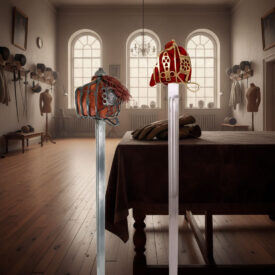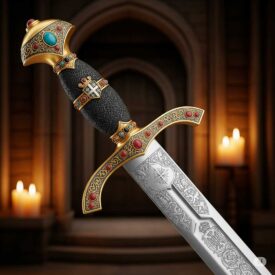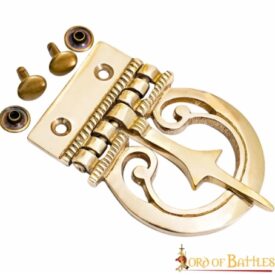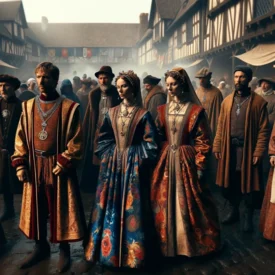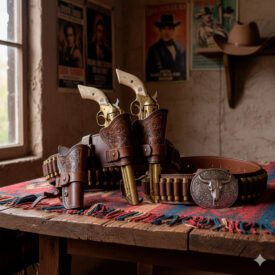What secrets does the blade of a sword that witnessed Scottish history and inspired legendary portraits hide? The Scottish Eglinton Sword is not just an object of metal and leather; it is a palpable fragment of Scotland’s warrior identity, an emblem forged in the crucible of battles and the resilience of a people. From its remarkable basket hilt to its legacy at Eglinton Castle, this iconic weapon invites us on an epic journey through time.
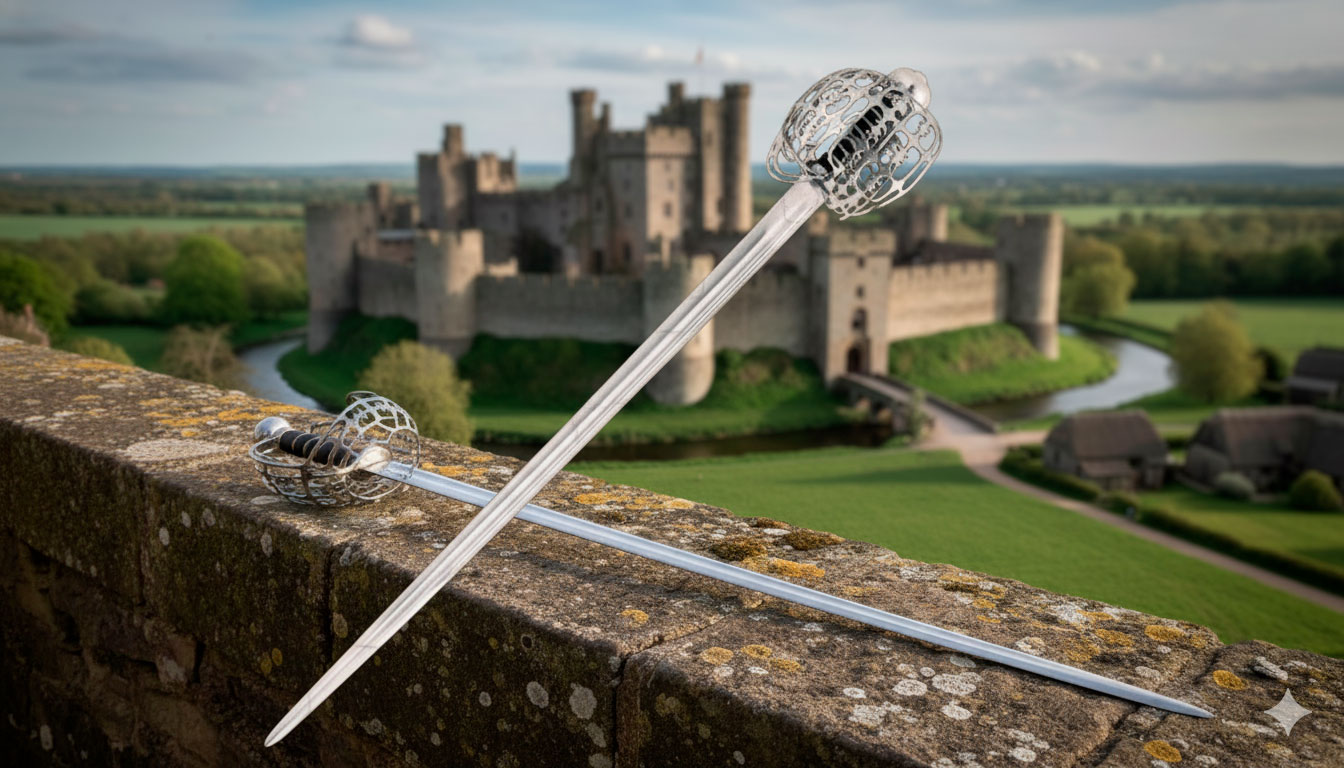
In this article, we will unveil the fascinating origin of the Eglinton Sword, its unique characteristics, and how it intertwines with the unbreakable spirit of the Highlanders. Prepare to immerse yourself in the history of one of the most captivating Scottish swords.
The Birth of an Icon: The Scottish Eglinton Sword in the 18th Century
The Scottish Eglinton sword is a testament to the design and craftsmanship of the mid-18th century, a period of cultural effervescence and conflict in Scotland. This weapon is not just another sword; it is the epitome of a Scottish Basket Hilt Back Sword, a design that provided unparalleled protection for the warrior’s hand in the heat of battle.
What makes it truly memorable is its basket-shaped hilt, whose steel lattice was not mere ornamentation but a vital innovation that protected the combatant. The blade, often double-grooved and masterfully forged, reflected an ancestral metallurgical tradition that sought excellence in every stroke.
The Eglinton Sword: Milestones and Historical Journey
| Era | Event |
|---|---|
| Mid-18th Century (c. 1750) | |
| Typological Identification | The sword is identified as a Scottish Basket Hilt Back Sword from the mid-18th century (c. 1750). |
| Origin of the nickname “Pinch of Snuff” | The nickname comes from a painting from c. 1750 attributed to William Delacour showing a basket-hilted sword alongside a Scottish officer of the 78th or Fraser’s Regiment. |
| Rarity | The sword is part of a group of which only about a dozen examples are known. |
| 19th Century (1839) | |
| Specimen at Eglinton Castle | A specimen with an oval opening in the handguard was formerly at Eglinton Castle, which sponsored and hosted the Eglinton Tournament. |
| Eglinton Tournament | The lavish medieval re-enactment event, known as the Eglinton Tournament, was held between August 28 and 30, 1839. |
| 20th Century – Present | |
| Abandonment of the castle | Eglinton Castle was abandoned in 1925. |
| Current location of the specimen | The Eglinton sword specimen from the castle (with an oval opening in the handguard) is now at the Royal Ontario Museum (ROM). |
| Production and sale of modern replicas | |
| Verified Review | A verified customer review for the “Eglinton Basket Sword” by Windlass Steelcrafts was submitted on September 8, 2020. |
| Replica manufacturer | The manufacturer of the replica is Windlass Steelcrafts. |
| Estimated dispatches (2025–2026) | Dispatches of replicas of basket-hilted Scottish swords were expected in late 2025 and early 2026; for example, several references had an estimated shipping date of January 2, 2026 (including models such as 88SB Scottish Broadsword and other Scottish Basket Hilt Broadsword and Backsword). |
| Importance | |
| Historical and artistic value | The sword is considered a “particularly magnificent and masterfully crafted” example of the iconic Highlander sword, and its name directly links it to the history and collection of Eglinton Castle. |
The Lineage of Eglinton Castle: Home to a Legend
The name “Eglinton” resonates with the grandeur of a Scottish castle, a crenellated Gothic stronghold in Kilwinning and the ancient home of the Earls of Eglinton. It was in this setting that an original specimen of the Eglinton Sword forged its legend. The castle was not only the cradle of this magnificent weapon but also the host of events that went down in history.

In 1839, Archibald Montgomerie, the Earl of Eglinton, organized a majestic medieval tournament on his estates that attracted the Victorian aristocracy, who, clad in armor, recreated the splendor of yesteryear. This event, although younger than the origin of the sword itself, consolidated its link with nobility and historical re-enactment, giving a new nuance to the legacy of this fascinating piece.
“The Pinch of Snuff”: A Portrait that Immortalized the Sword
The Scottish Eglinton Sword transcended the battlefield to be immortalized in art. It is in the portrait of an 18th-century Scottish Officer, titled “The Pinch of Snuff” and attributed to William Delacour, where this sword acquires another layer of mysticism. Around 1750, the painting captured the essence of an officer of the 78th or Fraser’s Regiment, with a prominent basket-hilted sword by his side.
This artistic representation not only certifies the existence and use of the sword at the time but also elevates it to the category of a symbol, a testament to the bravery and indomitable spirit of the Highlanders.
The Forging of Legend: Characteristics of Scottish Basket-Hilted Swords
Scottish basket-hilted swords, like the Eglinton, are a marvel of design and functionality. The actual grip, often wrapped in ray skin and twisted wire, not only ensures a firm hold but also provides unparalleled aesthetics. The blade, forged from high-carbon steel, reflects the mastery of Scottish blacksmiths, who perfected their techniques over centuries.
Features like the double grooving of the blade were no coincidence; they sought a perfect balance between weight, strength, and agility. Every modern replica of these swords, like those available here, seeks to honor that heritage, bringing to life the precision and splendor of the originals.
Scottish Swords for the Modern Collector
History and re-enactment enthusiasts know that a replica of a Scottish Eglinton sword is not just an object; it is a connection to a glorious past. Current replicas, such as those manufactured by Windlass Steelcrafts, aim to faithfully replicate the dimensions and spirit of historical pieces.
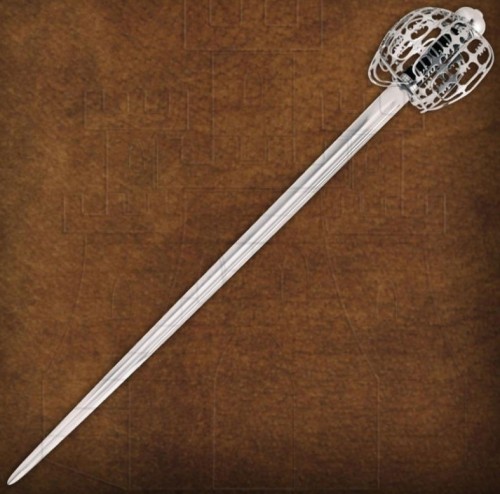
With materials like 1065 carbon steel and detailed hilts, these swords offer a tangible piece of history for collectors and practitioners of historical martial arts. The meticulousness in their manufacture ensures that each sword is a worthy tribute to the Scottish legacy.
Clarifying doubts about Scottish swords and their history
What is the main difference between the Eglinton sword and other Scottish swords?
The main difference between the Eglinton sword and other Scottish swords lies in its hilt: the Eglinton sword features a complex basket-shaped guard, while other Scottish swords, such as the Claymore, have a distinct guard with cross-guards and a triangular quillon for defense and specific combat maneuvers. Additionally, the Eglinton sword is typical of the 18th century and features a double-grooved blade, and its traditional hilt is clad in ray skin and coiled wire, providing a specific and functional design that distinguishes it.
What techniques were used to forge Scottish swords in the 18th century?
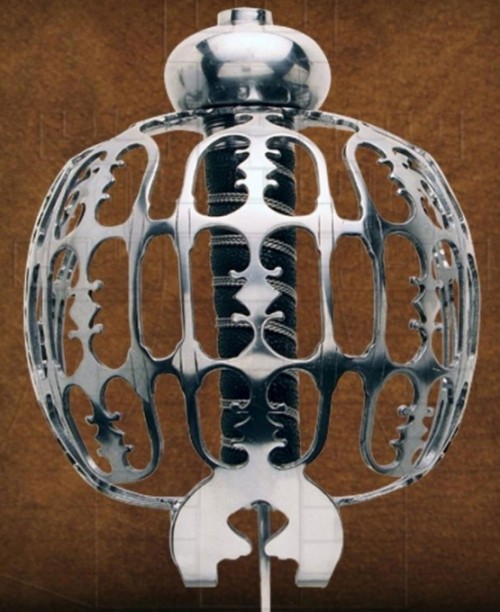 In the 18th century, Scottish blacksmiths employed highly developed forging methods that had been refined over centuries. The process began with the careful selection of high-quality steel, which was the fundamental basis for creating robust and flexible blades. Since Scotland did not have rich iron deposits, many armorers imported steel from European countries like Germany and Spain, known for their superior quality products.
In the 18th century, Scottish blacksmiths employed highly developed forging methods that had been refined over centuries. The process began with the careful selection of high-quality steel, which was the fundamental basis for creating robust and flexible blades. Since Scotland did not have rich iron deposits, many armorers imported steel from European countries like Germany and Spain, known for their superior quality products.
The manufacturing process was long and complex. Blacksmiths heated the steel in the forge until it glowed red, then repeatedly hammered and folded it to remove impurities and improve the metal’s structure. This technique, known as pattern welding, could be repeated hundreds of times until the blacksmith was satisfied with the final quality of the steel. Some blacksmiths even folded the steel up to 1000 times, depending on the desired result.
Once the basic shape was forged, the blade underwent a time-consuming sharpening and polishing process. Various grinding and polishing stones were used to produce a smooth, sharp edge. During this stage, the characteristic central line of the Claymore, called the Fuller, was incorporated, which not only reduced weight but also improved the weapon’s stability and balance.
For the final sharpening, specialized techniques such as concave sharpening were frequently used, where the blade surfaces were slightly concavely sharpened to reduce weight without compromising stability. Some blacksmiths also used traditional methods such as sharpening with leather or bamboo.
The hilt was crafted using wrapping techniques, the most common being wire wrapping. This method not only provided a good grip but also enhanced the appearance of the sword. Alternatively, spiral wrapping was used, where a single strip was placed in tight coils around the hilt. The wrapping had to be firm and durable to withstand intense use.
These processes required years of experience and artisan mastery, and the skills were passed down from generation to generation among Scottish armorers, who enjoyed great prestige in their time.
How did the Eglinton sword influence Scottish culture and identity?
The Eglinton sword influenced Scottish culture and identity by symbolizing the warrior spirit and the struggle for Scottish freedom, being a traditional emblem associated with the figure of the 18th-century Scottish warrior. It represents bravery and national pride, strengthening the connection with Scottish history and medieval identity. This sword, linked to the image of Scottish officers and their warrior culture, contributes to the perception of Scotland as a country with a rich tradition of defense and military honor.
What other examples of basket-hilted Scottish swords exist?
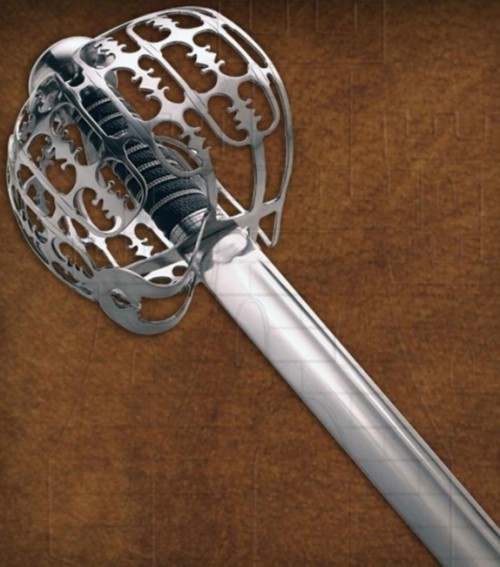 In addition to the Claymore basket-hilted sword, there are other examples of Scottish swords with this type of hilt, such as the Scottish broadsword and the loop-hilted basket sword. Regional variants such as the Bannockburn sword and the brass basket-hilted sword are also known, which often feature ornate designs and specific details of Scottish tradition.
In addition to the Claymore basket-hilted sword, there are other examples of Scottish swords with this type of hilt, such as the Scottish broadsword and the loop-hilted basket sword. Regional variants such as the Bannockburn sword and the brass basket-hilted sword are also known, which often feature ornate designs and specific details of Scottish tradition.
How are Scottish swords preserved and displayed in museums and collections?
Scottish swords, especially historical Claymores, are preserved and displayed in museums and collections through specialized techniques that include careful cleaning, stabilization of metal and organic components, and the creation of controlled storage conditions to prevent corrosion and deterioration. In some cases, technologies such as 3D scanning are used to document their structure without damaging them. For display, they are placed in suitable showcases that control humidity and light, and they are integrated into exhibitions that contextualize their historical and cultural value, also narrating the stories linked to the swords and their users. Notable examples include the National Museum of Scotland in Edinburgh and the Kelvingrove Gallery in Glasgow, where swords are part of permanent or special exhibitions with period settings and accompanying other military and personal related objects.
The Immortal Legacy of the Eglinton Sword
From the glorious Eglinton Castle to the annals of military history, the Scottish Eglinton Sword personifies the intrepid soul of Scotland. Every curve of its basket hilt and every detail of its forged blade are echoes of a past where honor and bravery were measured on the battlefield. It is a symbol of Scottish resilience, a reminder that history is not only written on parchments but also forged in steel.
Whether in replicas that honor its original design or in portraits that immortalized it, the Eglinton Sword continues to fascinate, inviting us to explore the fascinating universe of historical weapons and the culture that gave birth to them.
VIEW SCOTTISH BASKET-HILTED SWORDS | VIEW MORE SCOTTISH SWORDS | VIEW OTHER FUNCTIONAL SWORDS
